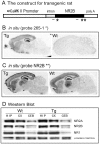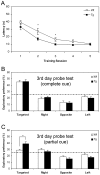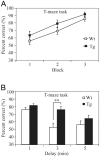Genetic enhancement of memory and long-term potentiation but not CA1 long-term depression in NR2B transgenic rats
- PMID: 19838302
- PMCID: PMC2759522
- DOI: 10.1371/journal.pone.0007486
Genetic enhancement of memory and long-term potentiation but not CA1 long-term depression in NR2B transgenic rats
Abstract
One major theory in learning and memory posits that the NR2B gene is a universal genetic factor that acts as rate-limiting molecule in controlling the optimal NMDA receptor's coincidence-detection property and subsequent learning and memory function across multiple animal species. If so, can memory function be enhanced via transgenic overexpression of NR2B in another species other than the previously reported mouse species? To examine these crucial issues, we generated transgenic rats in which NR2B is overexpressed in the cortex and hippocampus and investigated the role of NR2B gene in NMDA receptor-mediated synaptic plasticity and memory functions by combining electrophysiological technique with behavioral measurements. We found that overexpression of the NR2B subunit had no effect on CA1-LTD, but rather resulted in enhanced CA1-LTP and improved memory performances in novel object recognition test, spatial water maze, and delayed-to-nonmatch working memory test. Our slices recordings using NR2A- and NR2B-selective antagonists further demonstrate that the larger LTP in transgenic hippocampal slices was due to contribution from the increased NR2B-containing NMDARs. Therefore, our genetic experiments suggest that NR2B at CA1 synapses is not designated as a rate-limiting factor for the induction of long-term synaptic depression, but rather plays a crucial role in initiating the synaptic potentiation. Moreover, our studies provide strong evidence that the NR2B subunit represents a universal rate-limiting molecule for gating NMDA receptor's optimal coincidence-detection property and for enhancing memory function in adulthood across multiple mammalian species.
Conflict of interest statement
Figures






References
-
- Bliss T, Collingridge G. A synaptic model of memory: long-term potentiation in the hippocampus. Nature. 1993;361:31–39. - PubMed
-
- Malenka R, Nicoll R. NMDA-receptor-dependent synaptic plasticity: multiple forms and mechanisms. Trends Neurosci. 1993;16:521–527. - PubMed
-
- Bear M, Malenka R. Synaptic plasticity: LTP and LTD. Curr Opin Neurobiol. 1994;4:389–399. - PubMed
-
- Linden D, Connor J. Long-term synaptic depression. Annu Rev Neurosci. 1995;18:319–357. - PubMed
Publication types
MeSH terms
Substances
Grants and funding
LinkOut - more resources
Full Text Sources
Medical
Miscellaneous

